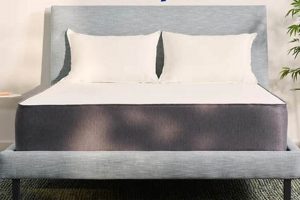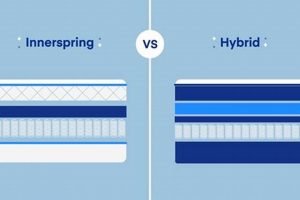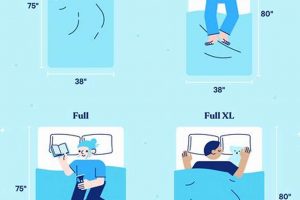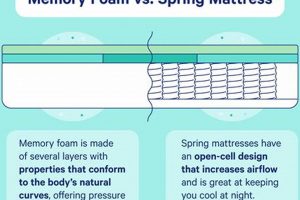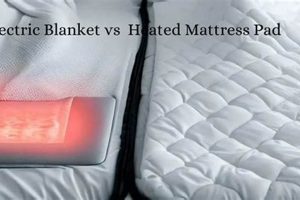Mattress selection often involves considering several major brands. Three prominent names in the industry offering a diverse range of sleep surfaces are Simmons, Sealy, and Serta. These companies manufacture mattresses using various materials and construction methods, each targeting different comfort preferences and price points.
The prevalence of these brands stems from decades of presence in the market. They have established a reputation, adapting to evolving consumer needs and technological advancements in sleep science. Their widespread availability and marketing efforts contribute to their recognition and the substantial share they hold in the mattress market.
A comprehensive comparison of the aforementioned brands necessitates an examination of their specific product lines, construction materials, firmness options, and available technologies. Factors such as coil systems, foam types, and cooling features distinguish these brands and contribute to individual sleep experiences and overall value.
Selecting a mattress requires careful consideration of individual needs and preferences. When evaluating options from leading manufacturers, several key factors should inform the decision-making process.
Tip 1: Research Specific Models: Avoid generalizations based solely on brand name. Each manufacturer offers numerous models with varying features, materials, and price points. Investigate the specifications of individual mattresses to determine suitability.
Tip 2: Consider Sleeping Position: Side sleepers typically require mattresses with enhanced pressure relief, while back and stomach sleepers often benefit from firmer support. Align the mattress choice with primary sleeping posture.
Tip 3: Evaluate Material Composition: Foam density, coil count, and material quality significantly impact mattress durability and performance. Research the materials used in each mattress and their associated benefits and drawbacks.
Tip 4: Assess Firmness Level: Mattress firmness is subjective, but consider personal preferences and physical needs. A too-soft mattress may lack support, while a too-firm mattress can cause pressure point discomfort.
Tip 5: Check Warranty and Return Policies: Review the manufacturer’s warranty and return policies before purchasing. A generous warranty and hassle-free return policy provide reassurance and protection against potential defects or dissatisfaction.
Tip 6: Read Customer Reviews: Gather insights from other consumers who have purchased and used the mattresses under consideration. Pay attention to recurring themes and patterns in the reviews to identify potential strengths and weaknesses.
Tip 7: Compare Prices and Features: Thoroughly compare prices and features across different models and brands. Avoid solely focusing on price; prioritize mattresses that offer the best combination of quality, comfort, and value.
Ultimately, the ideal mattress is one that provides optimal support, comfort, and durability, tailored to individual needs and preferences. Thorough research and careful consideration of these factors will increase the likelihood of a satisfactory purchase.
The following sections will delve into the specific offerings and characteristics of various mattress brands, providing a detailed comparison to further inform the selection process.
1. Construction and Materials
The composition and assembly of a mattress fundamentally determine its performance characteristics, influencing comfort, support, durability, and temperature regulation. In evaluating Simmons, Sealy, and Serta mattresses, a detailed examination of their construction and materials is essential for informed comparison.
- Coil Systems
The type and configuration of coils used within a mattress significantly impact its support and motion isolation capabilities. Simmons frequently employs pocketed coil systems designed to minimize motion transfer. Sealy often utilizes interconnected coil designs for enhanced overall support and stability. Serta commonly integrates variations of continuous coil systems, providing uniform surface firmness. The gauge and temper of the steel used in these coils influence their responsiveness and resistance to deformation over time.
- Foam Types
The foam layers within a mattress contribute substantially to its comfort and contouring properties. Memory foam, known for its pressure relief and body conforming qualities, is often incorporated by all three brands, though density and formulation may vary. Polyurethane foam serves as a support base and transition layer, with differing densities impacting the firmness and durability of the mattress. Latex foam, derived from natural or synthetic sources, offers a resilient and responsive feel, often found in higher-end models.
- Cover Materials
The outermost layer of a mattress, the cover, plays a crucial role in breathability and surface comfort. Common materials include cotton, polyester, and blends incorporating performance fabrics designed to wick away moisture and regulate temperature. The weave and thickness of the cover can influence the overall feel of the mattress and its resistance to wear and tear. Some covers are treated with antimicrobial or hypoallergenic finishes to enhance hygiene.
- Reinforcement and Edge Support
The perimeter of a mattress is often reinforced to provide consistent edge support and prevent sagging over time. Foam encasement systems, steel rods, or additional coil support along the edges enhance the usable sleep surface and contribute to the mattress’s overall structural integrity. This feature is particularly relevant for individuals who sleep near the edge of the bed or require assistance getting in and out of bed.
The interplay between these construction elementscoil systems, foam types, cover materials, and reinforcement featuresdetermines the overall feel and performance of Simmons, Sealy, and Serta mattresses. Understanding the specific materials and construction techniques employed by each brand is crucial for selecting a mattress that aligns with individual sleep preferences and needs.
2. Firmness and Support
Firmness and support constitute critical factors in mattress selection, directly influencing spinal alignment, pressure relief, and overall sleep comfort. The varying approaches taken by Simmons, Sealy, and Serta in designing these attributes represent a key differentiator for consumers.
- Firmness Levels and Perceived Comfort
Mattress firmness is typically categorized along a spectrum, ranging from ultra-plush to extra-firm. Perceived comfort, however, remains subjective. Simmons, Sealy, and Serta offer mattresses across this firmness range. A side sleeper, for example, might require a softer mattress for shoulder and hip pressure relief, while a stomach sleeper typically benefits from a firmer surface to prevent spinal curvature. Understanding personal comfort preferences and aligning them with the labeled firmness of a specific mattress model is essential. Inconsistent labeling practices across brands, however, necessitate in-person testing whenever feasible.
- Support Core Construction and Spinal Alignment
The support core, typically consisting of coils or dense foam, plays a primary role in maintaining proper spinal alignment. Simmons utilizes various coil systems, including pocketed coils designed to minimize motion transfer and contour to the body. Sealy often employs interconnected coil systems for enhanced overall support. Serta integrates variations of continuous coil systems and foam cores. The efficacy of these systems in promoting spinal alignment depends on the individuals weight, sleeping position, and the specific design characteristics of the mattress. A well-supported spine minimizes pressure points and reduces the risk of back pain.
- Zoned Support Systems and Targeted Pressure Relief
Some mattress models incorporate zoned support systems, featuring varying levels of firmness in different areas of the mattress. These zones are designed to provide targeted support to specific regions of the body, such as the lumbar region or the shoulders. Simmons, Sealy, and Serta offer mattresses with zoned support. These systems aim to optimize spinal alignment and reduce pressure points. For instance, a mattress may feature firmer support in the center to prevent spinal sagging and softer support in the shoulder area to accommodate side sleeping.
- Material Density and Long-Term Support
The density of the materials used in a mattress, particularly foams and coils, affects its long-term support and durability. Higher-density foams and thicker gauge coils tend to resist compression and maintain their shape over time. Simmons, Sealy, and Serta utilize varying densities of foam and gauges of coils across their product lines. Mattresses with inadequate material density may sag or develop impressions, compromising support and comfort. Evaluating the materials specifications of a mattress provides insight into its potential longevity.
The balance between firmness and support dictates the suitability of a mattress for a given individual. While firmness reflects the initial feel of the mattress, support pertains to its ability to maintain spinal alignment over time. The design choices made by Simmons, Sealy, and Serta regarding these attributes contribute significantly to the overall user experience and the long-term health of the sleeper.
3. Technology Integration
Technology integration within mattress design directly impacts sleep quality and comfort. Manufacturers such as Simmons, Sealy, and Serta incorporate various technologies aimed at enhancing these attributes. For instance, cooling technologies, utilizing gel-infused memory foam or breathable fabric covers, mitigate heat retention, a common concern in traditional mattresses. These innovations respond to consumer demand for temperature regulation, which is crucial for maintaining restful sleep. Targeted support systems, often achieved through varying coil densities or specialized foam layering, provide customized support to different areas of the body, promoting spinal alignment and pressure relief. This technological approach addresses the need for individualized comfort, accommodating diverse sleep positions and body types.
The integration of sensors and data analytics represents a further evolution in mattress technology. Some models incorporate sensors that track sleep patterns, providing users with insights into their sleep quality. This data can be used to optimize sleep habits and adjust mattress settings, where applicable. However, the effectiveness and privacy implications of these technologies remain subjects of ongoing discussion. Examples include adjustable air mattresses that allow users to customize firmness levels and smart beds that automatically adjust to individual sleep positions. The practical application of these advancements lies in empowering consumers with greater control over their sleep environment and providing data-driven recommendations for improved sleep hygiene.
In summary, technology integration plays a significant role in differentiating mattress offerings from Simmons, Sealy, and Serta. While cooling technologies and targeted support systems address immediate comfort needs, emerging technologies such as sleep tracking sensors offer potential for personalized sleep optimization. Challenges remain regarding data privacy and the validation of these technologies’ efficacy. However, the trend towards greater technology integration in mattress design reflects a growing emphasis on data-driven sleep solutions and personalized comfort preferences.
4. Price Point Variance
The range of prices associated with mattresses from Simmons, Sealy, and Serta is a significant factor in consumer decision-making. This price point variance stems from multiple factors, including materials used, construction complexity, technology integration, and brand positioning. Lower-priced models within each brand often feature simpler construction, less advanced materials, and fewer specialized features. Conversely, higher-end models typically incorporate premium materials, advanced coil systems, enhanced cooling technologies, and zoned support systems, justifying a higher price tag. The availability of financing options and promotional discounts further complicates the price landscape.
Price point variance directly affects accessibility to different comfort levels and technological features. A consumer on a limited budget may opt for a basic innerspring model from Sealy, prioritizing affordability over advanced features. Conversely, a consumer seeking enhanced comfort and support may choose a higher-priced memory foam or hybrid model from Simmons or Serta, valuing premium materials and advanced technologies. The perceived value proposition the ratio of perceived benefits to price is a critical determinant. The brands also strategically position certain models within specific price tiers to compete effectively in different market segments. For example, a Serta iComfort model often targets consumers seeking a mid-range memory foam option, while a Simmons Beautyrest Black model appeals to those seeking a luxury innerspring experience. The proliferation of online mattress retailers and direct-to-consumer brands has further intensified price competition, forcing traditional brands to adjust their pricing strategies and offer more competitive options.
Understanding the price point variance associated with Simmons, Sealy, and Serta mattresses empowers consumers to make informed purchasing decisions. Evaluating individual needs, comfort preferences, and budgetary constraints allows for a rational assessment of value. While higher-priced models may offer enhanced features and materials, affordability remains a crucial consideration for many consumers. Ultimately, the optimal choice involves balancing price, comfort, support, and durability to maximize long-term satisfaction. The increasing transparency in mattress pricing, facilitated by online resources and consumer reviews, further aids in this decision-making process.
5. Customer Satisfaction
Customer satisfaction serves as a crucial metric in evaluating the overall performance and consumer perception of mattress brands, including Simmons, Sealy, and Serta. It reflects the degree to which these brands meet or exceed customer expectations regarding comfort, support, durability, and value. Analyzing customer satisfaction data provides valuable insights into the strengths and weaknesses of each brand, informing purchasing decisions and driving product development.
- Comfort Expectations and Realization
Customer satisfaction is directly linked to the realization of comfort expectations. Consumers often purchase mattresses with specific comfort preferences in mind, such as plush, firm, or contouring. If a mattress fails to deliver the anticipated comfort level, customer satisfaction diminishes. Online reviews and surveys frequently cite comfort as a primary determinant of satisfaction, with negative feedback often highlighting issues like excessive firmness, inadequate support, or heat retention. For example, a customer purchasing a memory foam mattress may be dissatisfied if it sleeps too hot, regardless of other features.
- Durability and Longevity Perceptions
Customer satisfaction is profoundly influenced by perceptions of mattress durability and longevity. Consumers expect a mattress to maintain its comfort and support characteristics over an extended period. Reports of premature sagging, impressions, or coil breakdown can significantly erode satisfaction. Extended warranties often provide reassurance, but negative experiences with product durability outweigh the perceived benefits of warranty coverage. For instance, a customer reporting sagging within the first year of ownership is likely to express significant dissatisfaction, even if the mattress is covered by a warranty.
- Value for Money Assessment
Customer satisfaction hinges on a perceived balance between price and performance. Consumers assess whether the features and benefits of a mattress justify its cost. A high-priced mattress failing to deliver superior comfort or durability is likely to generate dissatisfaction. Conversely, a moderately priced mattress exceeding expectations can foster high levels of satisfaction. Value is subjective, but consumers often compare mattress prices and features across brands and models to determine whether they are receiving a fair deal. For example, a customer may be satisfied with a less expensive innerspring mattress if it provides adequate support, even if it lacks the advanced features of a pricier memory foam model.
- Brand Reputation and Trustworthiness
Customer satisfaction is closely intertwined with brand reputation and trustworthiness. Consumers are more likely to purchase mattresses from brands with a positive track record and a history of honoring warranty claims. Negative publicity or widespread reports of customer service issues can erode trust and diminish satisfaction. Brands that actively solicit and respond to customer feedback tend to cultivate stronger relationships and foster greater loyalty. For example, a consumer may be more inclined to purchase a Sealy mattress if they perceive the brand as reliable and reputable, even if competing brands offer similar features at a comparable price.
Customer satisfaction provides a comprehensive overview of how Simmons, Sealy, and Serta mattresses perform in the real world. By analyzing customer reviews, warranty claims, and satisfaction surveys, valuable insights can be gained regarding product strengths and weaknesses. Ultimately, customer satisfaction serves as a leading indicator of brand success and a crucial benchmark for ongoing product improvement efforts. The interplay of comfort realization, durability perceptions, value for money, and brand trustworthiness profoundly shapes consumer sentiment and influences purchasing decisions in the competitive mattress market.
Frequently Asked Questions
This section addresses common inquiries regarding mattresses manufactured by Simmons, Sealy, and Serta, providing objective information to aid in informed decision-making.
Question 1: What are the primary differences in construction among Simmons, Sealy, and Serta mattresses?
Simmons often emphasizes pocketed coil systems for motion isolation. Sealy typically utilizes interconnected coil designs for robust support. Serta frequently integrates gel-infused memory foam layers for enhanced comfort.
Question 2: How do the firmness levels of these brands compare?
All three brands offer mattresses across a range of firmness levels, from plush to extra-firm. However, subjective firmness perception may vary. In-person testing is recommended whenever possible.
Question 3: What technologies are commonly incorporated into these mattresses?
Cooling technologies, such as gel-infused foam and breathable covers, are prevalent. Zoned support systems, providing targeted support to different body regions, are also frequently featured.
Question 4: How does the price point variance among these brands affect consumer choices?
Price ranges vary significantly, reflecting differences in materials, construction, and technology. Consumers on a limited budget may opt for basic models, while those seeking premium features may choose higher-end options.
Question 5: What factors contribute to customer satisfaction with these brands?
Customer satisfaction is influenced by comfort realization, durability perceptions, value for money, and brand reputation. Positive customer experiences contribute to brand loyalty.
Question 6: Are there specific sleeping positions that are better suited to each brand’s mattresses?
Side sleepers typically benefit from mattresses with enhanced pressure relief, often found in softer models. Back and stomach sleepers generally require firmer support to maintain spinal alignment.
The information provided aims to clarify common questions regarding mattress selection. Individual needs and preferences should guide the final purchasing decision.
The subsequent section will delve into specific product recommendations based on individual sleep needs.
Conclusion
The preceding analysis has examined the comparative landscape of Simmons, Sealy, and Serta mattresses. Key distinctions in construction, firmness, technology integration, price point variance, and customer satisfaction have been identified. These factors collectively influence the suitability of each brand’s offerings for individual consumers.
Given the inherent subjectivity of comfort preferences and the variability of individual needs, the selection of a mattress requires careful consideration. Prospective purchasers are encouraged to conduct thorough research, test mattresses in person whenever feasible, and critically evaluate the factors outlined herein to arrive at an informed decision that aligns with their specific requirements and priorities. The long-term implications of this selection warrant a measured and deliberate approach.


![Firm vs Plush Mattress: Find Your Best Sleep [Guide] Organic & Natural Mattress Buyer’s Guide: Non-Toxic Sleep Solutions Firm vs Plush Mattress: Find Your Best Sleep [Guide] | Organic & Natural Mattress Buyer’s Guide: Non-Toxic Sleep Solutions](https://mattressworldpa.com/wp-content/uploads/2025/07/th-1112-300x200.jpg)
